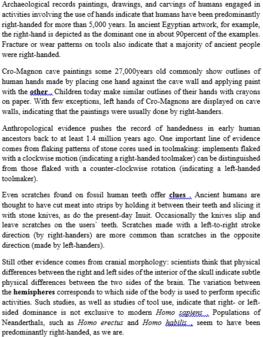Read the following passage and mark the letter A, B, C, or D on your answer sheet to indicate the correct answer to each of the questions from 28 to 34.
The iPhone was released in 2007. E-books reached the mainstream in the late 1990s. Printed books have been around since the 1450s. But how did writing move around before then? After all, a book - electronic or not - is simply a mechanism for making written information portable. And our ancestors were as eager to take their reading on the go as we are. Here are some ways that people used to record information and carry it around.
In Mesopotamia, in the 3rd millennium BCE, various ancient peoples began scribbling on small tablets that were several inches long. Scribes used a stylus to make marks on wet clay tablets, w hich were then dried outside or baked so as to make them long-lasting. Some particularly important texts ran across multiple tablets. The type of writing used by these scribes was cuneiform, and it sustained the production of these tablets for some 2,000 years.
The Chinese also created tablets that were made from bamboo or wood and were lashed together with the equivalent of rope. Records suggest that these may have emerged by 1300 BCE, if not before, but many simply rotted away or otherwise decayed. The emperor Shihuangdi also didn’t help in 213 BCE when he ordered that most books not in his possession be burned. During roughly the same time, the Chinese also created scrolls made of silk, though these scrolls were not always rolled into a cylindrical form; some of the documents written on silk that were found, for example, at Mawangdui, an archaeological site in southeastern China that dates to the 2nd century BCE, were found folded into rectangles. The texts on these tablets and scrolls covered a wide range of topics, from medicine to poetry to philosophy.
Wax tablets were a riff on the ancient Mesopotamian clay tablets, courtesy of the ancient Greeks and Romans. Clay tablets could be awkward to work with; papyrus could be a pain to prepare and store. But filling a wooden block with hot wax that, after it cooled, provided a smooth soft writing surface? Simple. And cheap too. Permanence was a bit of a problem, but it was also an advantage: the wax could be remelted or scraped smooth, and the tablet was ready for use again. The Greeks and the Romans, and medieval Europeans after them, used these tablets for some important legal documentation, but their primary advantage was flexibility—very much like a paper (or electronic) tablet today.
(Source: https://britannicalearn. com)
The word “them" in paragraph 2 refers to _____________
A. ancient peoples
B. scribes
C. clay tablets
D. important texts




Chọn C